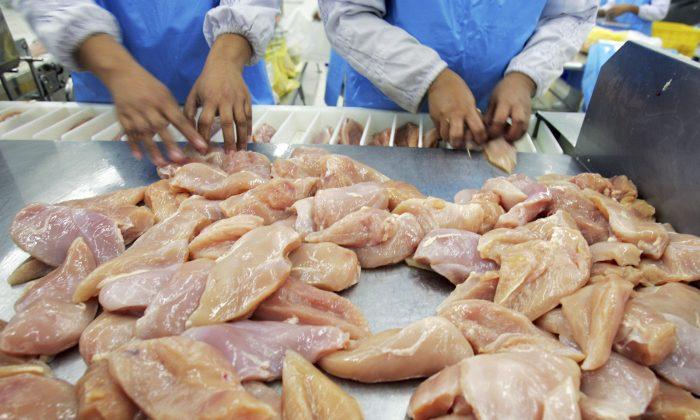Workers in U.S. poultry plants spend eight hours or more each day leaning over a conveyor belt, cutting, chopping, and folding chicken carcasses as they whiz by at a relentless 140 birds per minute (bpm).
But according to the U.S. Department of Agriculture (USDA), that’s not fast enough.
But that’s not fast enough for some.
If the U.S. Department of Agriculture (USDA) enacts a new set of rules called the Modernization of Poultry Slaughter Inspection, or HIMP, the maximum line speed would increase to 175 bpm. HIMP, which has been under testing at a small number of plants in Alabama since 1998, is set to go into effect in September 2013.
The goal of the new regulation is to change to focus of inspection from visible dangers, such as bruises or fecal matter, to the ever growing invisible danger: bacteria.
According to the USDA the two most dangerous bacteria, Salmonella and Campylobacter, are responsible for about 344,000 poultry-associated foodborne illnesses every year.
Dangerous Business
Meatpacking is big business. In 2009, meat and poultry industry sales totaled $154.8 billion, according to the American Meat Institute.
According to a 2005 report by the Government Accountability Office, “Meatpacking is one of the most dangerous industries in the United States.”
Poultry workers are almost twice as likely to suffer from an injury at work.
In 2010 the Occupational Health and Safety Administration (OSHA) reported a 5.9 percent injury rate for poultry processing workers, compared with 3.8 percent for all U.S. workers.
Tom Fritzsche, lawyer for the Southern Poverty Law Center (SPLC) attributes the majority of injuries to the speed of the conveyor belt carrying the carcasses, known as the “line speed.”
“Unsafe at These Speeds,” a report by the SPLC, details the conditions inside Alabama’s poultry plants:
“Inside these frigid plants, workers stand almost shoulder-to-shoulder as chicken carcasses zip by on high-speed processing lines. Together, small teams of workers may hang, gut or slice more than 100 birds in a single minute.”
Alabama is the third largest poultry processing state in the U.S., behind Georgia and Arkansas, producing 1 billion broilers a year.
According to an April 2013 study of workers in a South Carolina poultry processing plant done by the National Institute for Occupational Safety and Health (NIOSH), 42 percent of workers had evidence of carpal tunnel syndrome, caused by the repetitive motion of the work.
Fritzsche interviewed hundreds of plant workers about the factory conditions. He recalled the story of Fernanda who passed out while deboning carcasses. Her coworkers caught her as she fell and pulled her out of the way while the line continued speeding by.
Cuts and gashes are common, and workers risk exposure to chemicals and antibiotics used to clean the plants.
According to the SPLC report, workers are often penalized for stopping or slowing the line. This creates an environment of fear, and they hesitate to report injuries.
“In the industry’s rush to produce as much as they can, as fast as they can, anything having to do with worker safety is really an afterthought for them,” Fritzsche said.
Line speed is not only unsafe for workers, but it is also unsafe for the consumer, according to Fritzsche.
“When the plant runs at this breakneck pace, it causes more injuries, and it also increases the potential for contamination,” he said.
Inspectors who have worked at HIMP plants have been outspoken about the quality control issues at these plants as well as the dangers of reduced inspection.
A series of affidavits (4, 5, 6, 7), written by inspectors cataloguing their experience at HIMP plants, was released by the Food Integrity Campaign in May of 2012.
“Even if we could see every bird at that speed and we detect problems, we are not permitted to stop the line,” wrote an inspector in Affidavit #6.
Employees Fritzsche interviewed reported seeing chickens fall on the floor and get tossed back on the line without being washed in a frantic effort to keep the line moving.
Fewer Inspectors Will Cut Costs
According to the USDA, the new regulations would produce $90 million in savings for the department over a three-year period.
The savings would result from a decrease in the number of inspectors, from the current four, to only one per plant.
In HIMP plants company employees act as inspectors. The same untrained workers who are afraid to report injuries for fear of retaliation are responsible for doing work that is now done by trained USDA personnel.
A former plant supervisor turned USDA inspector voiced his concern about the use of company employee inspectors in Affidavit #7. He described his experience of the environment at a HIMP plant:
“Plant employees had it drilled into their heads that productivity and maintaining the production line was their chief responsibility ... we were encouraged to hide diseased or dirty chicken carcasses from the USDA inspectors in the plant and process it out to consumers.”
The new regulations were originally set to take effect in April of 2013, but have since been postponed, possibly due to vocal opposition from inspectors, unions, and food safety organizations.
The proposed changes will save the poultry industry an estimated $259.5 million per year. This is a benefit to the industry, 95 percent of which is controlled by eight companies.
The USDA is tasked with regulating and inspecting food production in the United States to ensure the safety of the food supply. It does not consider worker safety when writing regulations.
Yet, Under Secretary for Food Safety at the USDA, Dr. Elizabeth Hagen, does acknowledge that there are worker safety issues in the industry that need to be addressed, but does not believe this new form of inspection will increase the risk to workers.
In a blog post dated May 2, she stated “The data that we have to date does not show any link between this new type of inspection system and increased risk for poultry industry employees or our own inspection personnel.”
OSHA, the agency responsible for ensuring the safety of workers, released Ergonomic Guidelines for Poultry Processing in 2004, but there are no mandatory regulations.
Fritzsche does not question the new inspection system but he is not convinced that line speed increases need to be a part of the reform. “They could ask plants to switch over without changing the line speeds,” Fritzsche said.
According to Fritzsche the need to remain competitive will force plants to run at the maximum allowable speed and he fears that without regulation from OSHA this new regulation will make an already dangerous job even more so.





Friends Read Free